Geography of Djibouti
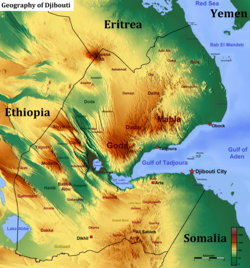 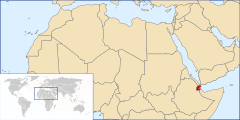 | |
| Continent | Africa |
|---|---|
| Region | Horn of Africa |
| Area | Ranked 146th |
| • Total | 23,200 km2(9,000 sq mi) |
| Coastline | 314 km (195 mi) |
| Borders | 575 km (357 mi) * * * * |
| Highest point | Mousa Ali 2,028 m (6,654 ft) |
| Lowest point | Lac Assal −155 m (−509 ft) |
| Largest lake | Lake Abbe |
| Terrain | Mostly mountainous and volcanic |
Djiboutiis a country in theHorn of Africa.It is bordered byEritreain the north,Ethiopiain the west and south, andSomaliain the southeast. To the east is its coastline on theRed Seaand theGulf of Aden.Rainfall is sparse, and most of the territory has a semi-arid to arid environment.Lake Assalis a saline lake which lies 155 m (509 ft) below sea level, making it the lowest point on land inAfricaand the third-lowest point on Earth after theSea of Galileeand theDead Sea.Djibouti has the fifth smallest population inAfrica.Djibouti's major settlements include the capitalDjibouti City,the port towns ofTadjouraandObock,and the southern cities ofAli SabiehandDikhil.It is the forty-six country by area inAfricaand 147st largest country in theworldby land area, covering a total of 23,200 km2(9,000 sq mi), of which 23,180 km2(8,950 sq mi) is land and 20 km2(7.7 sq mi) is water.[1]
Location[edit]
Djibouti shares 125 kilometres (78 mi) of border with Eritrea, 390 kilometres (240 mi) with Ethiopia, and 60 kilometres (37 mi) with Somalia (total 575 km or 357 mi). It has a strategic location on theHorn of Africaand theBab el Mandeb,along a route through theRed SeaandSuez Canal.Djibouti's coastline serves as a commercial gateway between theArabian Peninsulaand the Horn region's interior. The country is also the terminus ofrail traffic into Ethiopia.
Physiographic regions[edit]
Djibouti can be divided into threephysiographic regions
- The Northern Mountains
- Grand Bara
- The Southern Mountains
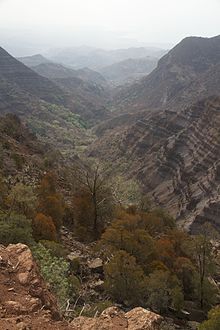
Mountains[edit]
A great arc of mountains, consisting of theMousa Ali,Goda Mountains,andArrei MountainssurroundsDjibouti.
Djibouti has eight mountain ranges with peaks of over 1,000 m (3,300 ft).[2]
- TheMousa Alirange is considered the country's highest mountain range, with the tallest peak on the border withEthiopiaandEritrea.It has an elevation of 2,063 m.[2]
- TheGoda Mountainslie northwest of theGulf of TadjourainTadjoura Region.They rise to 1,783 m (5,850 ft) above sea level and are the nation's largest heavily vegetated area.
- Garbiis a mountain in the west of Tadjourah Region. It has an elevation of 1,680 metres (5,510 feet).
- TheMabla Mountainsare located inObock Region.At 1,780 m (5,840 ft) above sea level, the mountains are situated behind the coastal plain where the Red Sea meets the Gulf of Aden, on the northern side of the Gulf of Tadjoura.
- TheArrei Mountainsare in the southernAli Sabieh Region.The mountain range has an elevation of 1,301 metres (4,268 feet) above sea level, and is situated near the border with Ethiopia.
- TheDagouein Mountainsit at an elevation of 1,124 m (3,688 ft) above sea level.
- Hemed is a mountain in the western part of theArta Regionin south-central Djibouti. The summit is 1,103 metres (3,619 feet) above sea level.
- TheBoura Mountains' highest peak has an elevation of 1,003 m (3,291 ft). The ecology of this landform issemi-desert.The altitude and size of the range affects its weather, with precipitation levels varying greatly and climatic conditions consisting of distinct zones.
Grand Bara[edit]

TheGrand BaraDesert covers parts of southern Djibouti in the Arta Region, Ali Sabieh Region andDikhil Region.The majority of the Grand Bara Desert lies at a relatively low elevation, below 1,700 feet (520 m). Home of the popular Grand Bara footrace.
Coasts[edit]
Most of Djibouti has been described as part of theEthiopian xeric grasslands and shrublandsecoregion.The exception is a strip along theRed Seacoast, which is part of theEritrean coastal desert;it is noted as an important migration route for birds of prey.[3]

Regions[edit]
The area of the regions ofDjiboutiis set out in the table below.
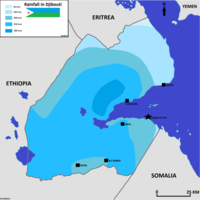
| Rank | Name | Area |
|---|---|---|
| 1 | Dikhil Region | 7,200 km2 |
| 2 | Tadjourah Region | 7,100 km2 |
| 3 | Obock Region | 4,700 km2 |
| 4 | Ali Sabieh Region | 2,200 km2 |
| 5 | Arta Region | 1,800 km2 |
| 6 | Djibouti Region | 200 km2 |
Climate[edit]
There is not much seasonal variation in Djibouti'sclimate.Hot conditions prevail year-round along with winter rainfall. Mean daily maximum temperatures range from 32 to 41 °C (90 to 106 °F), except at high elevations. InDjibouti City,for instance, afternoon highs in April typically range from 28 to 34 °C (82 to 93 °F) in April. Nationally, mean daily minima generally vary between sites from about 15 to 30 °C (59 to 86 °F). The greatest range in climate occurs in eastern Djibouti, where temperatures sometimes surpass 41 °C (106 °F) in July on the littoral plains and fall below freezing point during December in the highlands. In this region, relative humidity ranges from about 40% in the mid-afternoon to 85% at night, changing somewhat according to the season.

Djibouti has 988,000 people living there. Djibouti has either ahot semi-arid climate(BSh) or ahot desert climate(BWh), althoughtemperaturesare much moderated at the highelevations.On thecoastal seaboard,annualrainfallis less than 5 inches (130 mm); in thehighlands,it is about 8 to 16 inches (200 to 410 millimetres).[citation needed]Although the coastal regions are hot and humid throughout the year, the hinterland is typically hot and dry. The climate conditions are highly variable within the country and vary locally by altitude.[citation needed]Summers are very humid along the coast but dry in thehighlands.Heat waves are frequent. Annual precipitation amounts vary greatly from one year to another. In general, rain falls more frequently and extensively in the mountains.[citation needed]Sudden and brutal storms are also known to occur. Wadis turn for a few hours into raging torrents tearing everything in their path, and their course is regularized[clarification needed].Rainwater serves as an additional water supply for livestock and plants alongside seasonal watercourses. The highlands have temperate climate throughout the year. The climate of most lowland zones is arid and semiarid.
The climate of the interior shows notable differences from the coastline. Especially in the mornings, the temperature is pleasant: it is so inArta,Randaand Day (where temperatures of 10 degrees Celsius have been recorded).
Climate charts of different locations in Djibouti[edit]
| Djibouti City | ||||||||||||||||||||||||||||||||||||||||||||||||||||||||||||
|---|---|---|---|---|---|---|---|---|---|---|---|---|---|---|---|---|---|---|---|---|---|---|---|---|---|---|---|---|---|---|---|---|---|---|---|---|---|---|---|---|---|---|---|---|---|---|---|---|---|---|---|---|---|---|---|---|---|---|---|---|
| Climate chart (explanation) | ||||||||||||||||||||||||||||||||||||||||||||||||||||||||||||
| ||||||||||||||||||||||||||||||||||||||||||||||||||||||||||||
| ||||||||||||||||||||||||||||||||||||||||||||||||||||||||||||
| Arta | ||||||||||||||||||||||||||||||||||||||||||||||||||||||||||||
|---|---|---|---|---|---|---|---|---|---|---|---|---|---|---|---|---|---|---|---|---|---|---|---|---|---|---|---|---|---|---|---|---|---|---|---|---|---|---|---|---|---|---|---|---|---|---|---|---|---|---|---|---|---|---|---|---|---|---|---|---|
| Climate chart (explanation) | ||||||||||||||||||||||||||||||||||||||||||||||||||||||||||||
| ||||||||||||||||||||||||||||||||||||||||||||||||||||||||||||
| ||||||||||||||||||||||||||||||||||||||||||||||||||||||||||||
| Holhol | ||||||||||||||||||||||||||||||||||||||||||||||||||||||||||||
|---|---|---|---|---|---|---|---|---|---|---|---|---|---|---|---|---|---|---|---|---|---|---|---|---|---|---|---|---|---|---|---|---|---|---|---|---|---|---|---|---|---|---|---|---|---|---|---|---|---|---|---|---|---|---|---|---|---|---|---|---|
| Climate chart (explanation) | ||||||||||||||||||||||||||||||||||||||||||||||||||||||||||||
| ||||||||||||||||||||||||||||||||||||||||||||||||||||||||||||
| ||||||||||||||||||||||||||||||||||||||||||||||||||||||||||||
| Ali Sabieh | ||||||||||||||||||||||||||||||||||||||||||||||||||||||||||||
|---|---|---|---|---|---|---|---|---|---|---|---|---|---|---|---|---|---|---|---|---|---|---|---|---|---|---|---|---|---|---|---|---|---|---|---|---|---|---|---|---|---|---|---|---|---|---|---|---|---|---|---|---|---|---|---|---|---|---|---|---|
| Climate chart (explanation) | ||||||||||||||||||||||||||||||||||||||||||||||||||||||||||||
| ||||||||||||||||||||||||||||||||||||||||||||||||||||||||||||
| ||||||||||||||||||||||||||||||||||||||||||||||||||||||||||||
| Dikhil | ||||||||||||||||||||||||||||||||||||||||||||||||||||||||||||
|---|---|---|---|---|---|---|---|---|---|---|---|---|---|---|---|---|---|---|---|---|---|---|---|---|---|---|---|---|---|---|---|---|---|---|---|---|---|---|---|---|---|---|---|---|---|---|---|---|---|---|---|---|---|---|---|---|---|---|---|---|
| Climate chart (explanation) | ||||||||||||||||||||||||||||||||||||||||||||||||||||||||||||
| ||||||||||||||||||||||||||||||||||||||||||||||||||||||||||||
| ||||||||||||||||||||||||||||||||||||||||||||||||||||||||||||
| Airolaf | ||||||||||||||||||||||||||||||||||||||||||||||||||||||||||||
|---|---|---|---|---|---|---|---|---|---|---|---|---|---|---|---|---|---|---|---|---|---|---|---|---|---|---|---|---|---|---|---|---|---|---|---|---|---|---|---|---|---|---|---|---|---|---|---|---|---|---|---|---|---|---|---|---|---|---|---|---|
| Climate chart (explanation) | ||||||||||||||||||||||||||||||||||||||||||||||||||||||||||||
| ||||||||||||||||||||||||||||||||||||||||||||||||||||||||||||
| ||||||||||||||||||||||||||||||||||||||||||||||||||||||||||||
| Alaili Dadda | ||||||||||||||||||||||||||||||||||||||||||||||||||||||||||||
|---|---|---|---|---|---|---|---|---|---|---|---|---|---|---|---|---|---|---|---|---|---|---|---|---|---|---|---|---|---|---|---|---|---|---|---|---|---|---|---|---|---|---|---|---|---|---|---|---|---|---|---|---|---|---|---|---|---|---|---|---|
| Climate chart (explanation) | ||||||||||||||||||||||||||||||||||||||||||||||||||||||||||||
| ||||||||||||||||||||||||||||||||||||||||||||||||||||||||||||
| ||||||||||||||||||||||||||||||||||||||||||||||||||||||||||||
| Yoboki | ||||||||||||||||||||||||||||||||||||||||||||||||||||||||||||
|---|---|---|---|---|---|---|---|---|---|---|---|---|---|---|---|---|---|---|---|---|---|---|---|---|---|---|---|---|---|---|---|---|---|---|---|---|---|---|---|---|---|---|---|---|---|---|---|---|---|---|---|---|---|---|---|---|---|---|---|---|
| Climate chart (explanation) | ||||||||||||||||||||||||||||||||||||||||||||||||||||||||||||
| ||||||||||||||||||||||||||||||||||||||||||||||||||||||||||||
| ||||||||||||||||||||||||||||||||||||||||||||||||||||||||||||
Graphically the seasons can be represented this way:
| Month | Dec | Jan | Feb | Mar | Apr | May | Jun | Jul | Aug | Sep | Oct | Nov |
|---|---|---|---|---|---|---|---|---|---|---|---|---|
| Season | Winter|Jilaal | Summer/Hagaa | Winter|Jilaal | |||||||||
| Temperature | Cool | Very Hot | Cool | |||||||||
Selected elevations of notable locations[edit]
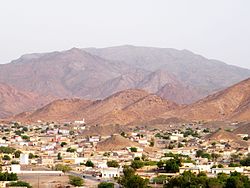

| Location | Region | Elevation (feet) |
Elevation (metres) |
|---|---|---|---|
| Mousa Ali | Tadjourah | 6,631 ft | 2,028 m |
| Goda Mountains | Tadjourah | 5,840 ft | 1,780 m |
| Garbi | Tadjourah | 5,512 ft | 1,680 m |
| Yaguer | Dikhil | 4,524 ft | 1,379 m |
| Mabla Mountains | Obock | 4,511 ft | 1,375 m |
| Arrei Mountains | Ali Sabieh | 4,268 ft | 1,301 m |
| Dagouein Mountain | Ali Sabieh | 3,688 ft | 1,124 m |
| Hemed | Arta | 3,619 ft | 1,103 m |
| Boura Mountains | Ali Sabieh | 3,291 ft | 1,003 m |
| Arta Mountains | Arta | 2,477 ft | 755 m |
| Lake Assal | Tadjourah | – 509 ft | – 155 m |
Lake Assal is the lowest point in Africa.
Resources and land use[edit]

Land use:
arable land:0.1%
permanent pasture:73.3%
forest:0.2%
other:26.4% (2011)
Irrigated land:10 km2(3.86 sq mi) (2012)
Water in Djibouti[edit]
Wateris becoming a scarce resource in Djibouti due toclimate change,which leads to different rainfall patterns as well as to inefficient methods of distribution within the country. Most of Djibouti's rainfall is in the four months, but over the last 25 years, the Djibouti's Ministry of Environment estimates that rainfall has decreased overall between 5 and 20 percent. It is predicted that in future years, there will be higher temperatures, lower rainfall, and longerdroughts,leading to even less access to water. Moreover, seawater intrusion or fossil saltwater contamination of the limited freshwater aquifers due togroundwater overexploitationaffect those who live close to the coastline.[4]
In recent years[when?],population growth has increased rapidly with the addition of many refugees.
Natural resources[edit]
Unlike much of theHorn of AfricaandMiddle Eastwhich is rich in lucrative crude oil,Djiboutihas limited natural resources. These include potential geothermal power,gold,clay, granite,limestone,marble,salt,diatomite, gypsum, pumice, petroleum.
Environment[edit]
Natural hazards include earthquakes, drought, and occasionalcyclonic disturbancesfrom theIndian Ocean,which bring heavy rains, andflash floods.Natural resourcesincludegeothermal energy.Inadequate supplies ofpotable water,limited arable land anddesertificationare current issues.
Djibouti is a party to international agreements onbiodiversity,climate change,desertification,endangered species,Law of the Sea,ozone layer protection, ship pollution, and wetlands.
Coastline[edit]

Djiboutihas a coastline which measures about 314 kilometres (195 miles). Much of thecoastlineis accessible and quite varied in geography and habitats.
Inlets[edit]
Maritime claims[edit]
- Territorial sea:12 nautical miles (22.2 km; 13.8 mi)
- Contiguous zone:24nautical miles(44.4 km; 27.6 mi)
- Exclusive economic zone:200 nautical miles (370.4 km; 230.2 mi)
Human geography[edit]

The population of Djibouti in 2015 was 846,000.
For statistical purposes, the country has three areas;Djibouti City(population 529,000),Ali Sabieh(population 55,000), andDikhil(population 54,000). Djibouti's population is diverse demographically; 60%Somali,35%Afar,and 3%Arabs.In terms of religion, 94%Muslim,6%Christian.
Extreme points[edit]
This is a list of the extreme points ofDjibouti,the points that are farther north, south, east or west than any other location.
- Northernmost point –Ras Doumera,Obock Region
- Northernmost point (mainland) – the point at which the border withEritreaenters theRed Sea,Obock Region
- Easternmost point – unnamed section of the Red Sea coast north ofRas Bir,Obock Region
- Southernmost point – unnamed location on the border withEthiopiawest of the town ofAs Ela,Dikhil Region
- Westernmost point – unnamed location on the border with Ethiopia immediately east of the Ethiopian town ofAfambo,Dikhil Region
References[edit]
- ^"Djibouti".The World Factbook.CIA. April 16, 2015.RetrievedApril 15,2015.
- ^ab"Highest Mountains in Djibouti".
- ^"Eritrean coastal desert".Terrestrial Ecoregions.World Wildlife Fund.
- ^Awaleh, Mohamed Osman; Boschetti, Tiziano; Soubaneh, Youssouf Djibril; Kim, Yongje; Baudron, Paul; Kawalieh, Ali Dirir; Ahmed, Moussa Mahdi; Daoud, Mohamed Ahmed; Dabar, Omar Assowe; Kadieh, Ibrahim Houssein; Adiyaman, Özlem; Elmi, Sikie Abdillahi; Chirdon, Mahamoud Ali (2018). "Geochemical, multi-isotopic studies and geothermal potential evaluation of the complex Djibouti volcanic aquifer (Republic of Djibouti)".Applied Geochemistry.97:301–321.Bibcode:2018ApGC...97..301A.doi:10.1016/j.apgeochem.2018.07.019.S2CID134565958.


